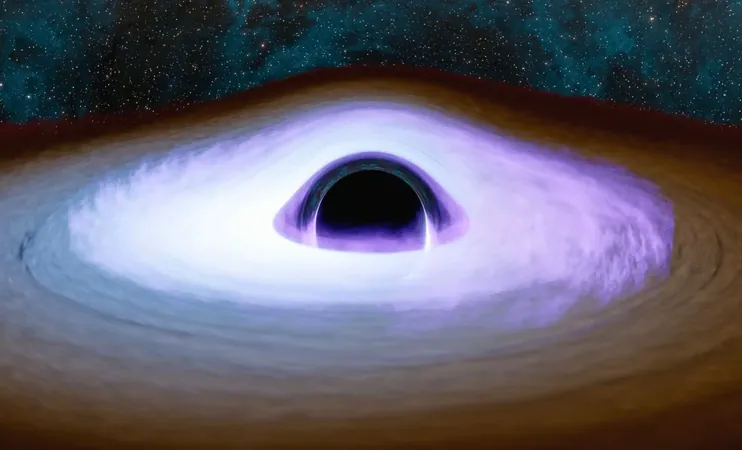
Groundbreaking Discovery: Scientists Reveal the Complex Structure of a Black Hole's 'Corona' for the First Time
2024-11-20
Author: Ting
In an extraordinary leap forward in astrophysics, astronomers have successfully unraveled the structure of black hole coronae, a feat that has baffled scientists for years. This pioneering study, published in The Astrophysical Journal, offers unprecedented insights into the dynamic behavior of black holes, reshaping our understanding of these cosmic giants.
What is the Corona of a Black Hole?
The corona of a black hole is an ultra-hot, turbulent region of ionized matter surrounding its innermost areas, particularly the accretion disk—a swirling mass of gas and dust spiraling into the black hole. What sets black hole coronae apart from the Sun's corona, which reaches millions of degrees, is their staggering temperature that can soar to billions of degrees Kelvin. This extreme heat arises from the intense gravitational forces at play near the event horizon, causing the material to emit high-energy X-rays that provide valuable clues about the surrounding environment.
Black hole coronae have significant implications for active galactic nuclei (AGNs)—powerful and energetic regions around supermassive black holes in distant galaxies. Depending on the orientation of a black hole relative to our line of sight, AGNs can appear bright or cloaked in shadows. Therefore, the intricate structure and dynamics of the corona are pivotal for understanding how we observe these phenomena.
Fascinating Characteristics of Black Hole Coronae:
- Temperature: A staggering range of billions of degrees Kelvin. - Density: Extremely diffuse, resembling a near-vacuum state. - Emission: A spectrum rich in high-energy X-rays and gamma rays.
Comprehending the dynamics of the corona helps elucidate how black holes consume material from their accretion disks and generate powerful jets of energy that can influence galaxy formation and evolution.
The Innovative Techniques Behind the Discovery
Studying the coronae of black holes has long been challenging due to the blinding light emitted by the accretion disk. However, the researchers employed NASA’s Imaging X-ray Polarimetry Explorer (IXPE) to sidestep this issue. By examining obscured black holes—where a toroidal structure of gas and dust blocks the bright emissions—scientists could focus instead on the scattered X-rays reflected by the surrounding torus material. This unique method allowed them to isolate emissions from the corona itself.
In their study, the team scrutinized a dozen dimmed black holes, including prominent ones like Cygnus X-1, a well-known black hole in our Milky Way galaxy, and LMG X-1 in the Large Magellanic Cloud. The findings revealed that contrary to previous assumptions of a spherical corona, the structure is actually elongated and flattened, akin to a disk aligning with the accretion disk.
Revolutionary Implications for Black Hole Physics
The revelation of a disk-like corona offers transformative insights into how black holes operate. Previously, models depicted the corona as a simplistic spherical shell surrounding the black hole, mirroring the structure of the Sun’s corona. This new evidence, however, indicates a more complex interplay between the corona and the accretion disk—a relationship that may significantly affect energy emissions from the black hole.
The flattened structure of the corona is likely instrumental in shaping the powerful jets of ionized gas that shoot out from the black hole’s poles. These jets are not only iconic features of AGNs but are also vital in understanding how they interact with their cosmic environments, potentially influencing processes like galaxy formation and evolution over cosmic time scales.
With these exciting discoveries, the field of black hole physics is poised for further exploration, opening doors to new research avenues. Scientists may soon answer some of the most pressing questions about the universe’s most notorious entities, bringing us closer to understanding the mysteries of space and time itself. Stay tuned for more updates as we continue to unveil the secrets of black holes!



 Brasil (PT)
Brasil (PT)
 Canada (EN)
Canada (EN)
 Chile (ES)
Chile (ES)
 España (ES)
España (ES)
 France (FR)
France (FR)
 Hong Kong (EN)
Hong Kong (EN)
 Italia (IT)
Italia (IT)
 日本 (JA)
日本 (JA)
 Magyarország (HU)
Magyarország (HU)
 Norge (NO)
Norge (NO)
 Polska (PL)
Polska (PL)
 Schweiz (DE)
Schweiz (DE)
 Singapore (EN)
Singapore (EN)
 Sverige (SV)
Sverige (SV)
 Suomi (FI)
Suomi (FI)
 Türkiye (TR)
Türkiye (TR)